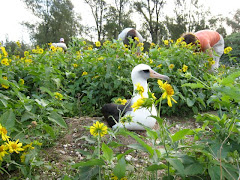
Call of the Albatross
Besides being surrounded by thousands of miles of ocean, the most significant natural phenomenon on this island are the albatross. You cannot go anywhere or e
 ven look out a window without encountering them. The sleek, smooth-feathered adults with their smoky eyes and regal posture to the gawky, fuzzy-headed or Mohawked youngsters scattered across acres and acres as they patiently await the next incoming flight of food.
ven look out a window without encountering them. The sleek, smooth-feathered adults with their smoky eyes and regal posture to the gawky, fuzzy-headed or Mohawked youngsters scattered across acres and acres as they patiently await the next incoming flight of food.Today John Klavitter, the refuge biologist, gave us a primer on the three species of albatross. An unfortunate side of his talk had to do with marine debris. Twenty tons of plastic accidentally arrives on the island every year. Twenty tons! Twenty-two percent of that is identifiable as coming from land sources, eighteen percent from ocean sources and the remaining sixty percent’s source is unidentifiable. He told us that fifty-five percent of the terrestrial plastic was bottle caps. With a few quick calculations I came up with 4850 lbs of bottle caps coming to this island per year! I don’t think it would be an exaggeration to say that at least half of those (probably more than a ton) are being fed to albatross chicks.
I am committed to make a difference in stopping this unnecessary deluge.


















When I visited Midway in January 2008, I first learned about the issues associated with marine debris. It really struck me when we examined the contents of dead albatross and saw huge amounts of plastic in several stomachs. To help reduce the marine debris issue, Aveda collects plastic bottle tops and recycles them to use in their product packaging. It's a pretty cool program. You can learn more about it here: http://aveda.aveda.com/aboutaveda/caps.asp
ReplyDelete